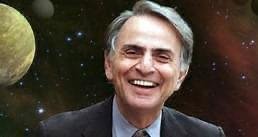Carl Sagan on #Hinduism
"In his landmark TV series Cosmos, Carl Sagan called Hinduism the only religion whose time-scale for the universe matches the billions of years documented by modern science. Sagan filmed that segment in a Hindu temple featuring a statue of the god Shiva as the cosmic dancer, an image that now stands in the plaza of the European Organization for Nuclear Research in Geneva."




It would be helpful to use the term “Sanatana Dharma” instead of “Hinduism”.
Lets look at the word “Shivoham” – composed of two words “Shiva” and “Aham” – “that which is not” Aham.
So, essentially, when you’re uttering the word Shivoham several times, you’re consciously moving away from the Aham and saying that you are not the Aham. (The Identity).
Now, the “that which is not” indicates “Nothing”. The vast Nothingness in the Cosmos. Yatha Pinda Tatha Brahmaanda. Vast Nothingness in the Cosmos and Vast Nothingness in the Atom. That is Shiva.
The rest (however insignificant it may be) is Shakti. Even though Shiva is Vast, he is Nothing. Even though Shakti is insignificant, she is something.
This is probably what the scientists at CERN realized and kept a small statue for.
Please let us know how –
1. The Hindu religion is a Faith
2. Shiva is a God
3. What is a God